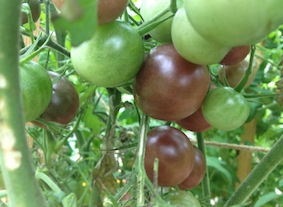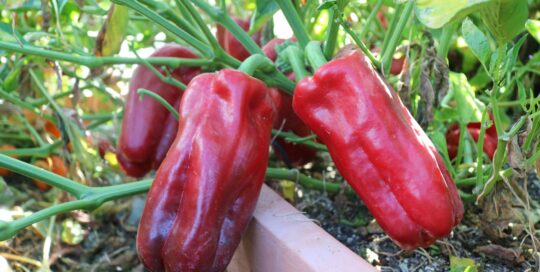Discovering Black Cherry Tomatoes
Views: 3314

Never underestimate the importance of plant labels. I’ve been living with at least six tomato plants (three of one variety, three of another) in my garden plot that have been unidentified since the day they went into the ground. One, is apparently, Black Cherry Tomatoes.
How’d that happen? The garden center had printed the tags on sticky labels then stuck them to blank plastic tags. The very night the plants went into the ground, we got a pretty good rainstorm and the printed labels disintegrated. Those two variety names were lost in the rush that is spring planting. One variety is a non-descript round, red tomato. No big deal. The other variety has grown into a trio of towering vining plants.
Early on I could tell they were cherry tomatoes of some sort. Then I was surprised to see them turn not red but purple. And they were some of the sweetest, mellowest cherry tomatoes I’ve ever had. I was finally able to identify them in the third week in August as a variety called Black Cherry.
Identifying Black Cherry Tomatoes
An online description calls these indeterminate-type tomatoes “sprawling” and “vigorous.” I agree with that, too. They are now about 5 feet tall and still going. As for the color—it’s not black, per say, but more of a dark purple/mahogany. If picked when a tad bit light, the fruit isn’t as sweet as when the cherries are allowed to ripen to their darkest color.
The fruits, by the way, are about an inch round. Each plant produces tons of clusters, each one with 10 or more fruit. About that sweet but mellow tomato flavor—it tastes to me like this variety has low acidity. More of the sweet flavor is then allowed to come to the fore.
Bon Appetit!
And what do you do with Black Cherry tomatoes? Pop them in a green salad. Slice in half and pair with fresh mozzarella for a mini caprese salad. Or—my new favorite thing—make Black Cherry Ketchup.
Ketchup? At least that’s what I am calling it. Roast 2 lbs. of Black Cherry tomatoes with a bit of olive oil, salt and pepper at 425F for 45 minutes. Run them through a food mill, then squeeze the skins and pulp through a sieve to extract the liquids (chuck the skins and pulp into the compost). Boil that liquid down until nice and thick. So, so good.
Bon appétit!
Meet Ellen Wells
When you’re raised on a farm, you can’t help but know a thing or two about gardening. Ellen Wells is our expert on edible gardening.…
Ellen's Recent Posts

Pepper Red Impact an All-America Selections Winner






